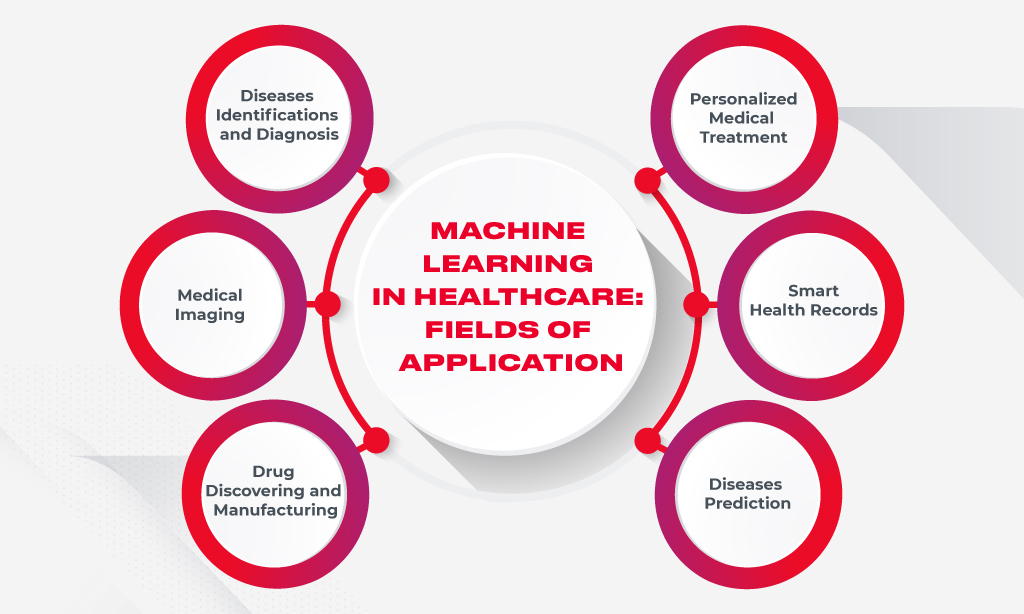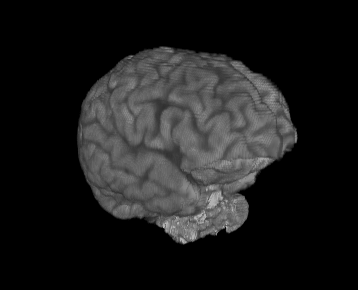Machine Learning In Healthcare To Enhance Your Solution
The American Hospital Association has published its 2020 strategic report to the Healthcare IT News Platform. Among the other top trends, machine learning in healthcare as an effective solution was singled out. Telehealth and AI technologies were also emphasized as being capable of helping health systems in dealing with staff shortages, impacting the skills and competencies needed, securing patients’ health records, and increasing clinical opportunities immensely.
Widespread usage of machine learning and AI is predicted in the following fields: administrative, financial, operational, and clinical. Considering these facts, custom healthtach software development seems to be highly demanded to improve monitoring of people’s health, assist in disease predictions, and protect data. Let’s see it in more detail.
How ML Can Improve Healthcare Industry
Machine learning in healthcare changes the way doctors practice and enhances their current role. A variety of challenges are outlined right now to help professionals in their everyday routine such as:
- providing health records
- diagnostics
- finding effective personal medical treatment
- managing their time at the hospital
- predicting drug effects
- storing and securing patients’ data
Basic Glimpses of ML in Healthcare
Human intelligence can hardly be compared to any other phenomenon. ML intelligence in healthcare has a lot of possibilities to improve the smart decisions made by humans. The specific benefits of involving AI into medicine (considered on the basis of the annual report of Harvard Medical School, ‘MD vs. Machine) include:
- accurate data (for example, the set of images of breast cancer and tumor dimensions give the possibility to identify the tumor as malignant based on its size) can inform specialists about typical patterns (e.g. what cancer kind it is);
- AI can perform as well as a human does and nullifies stress and exhaustion factors;
- new medications are invented, decreasing people’s suffering;
- data sets (managed and designed by IT specialists) can train machine learning algorithms and models to address key drug production problems: curing more people under lower cost and preserving the personalized approach.
AI uses sophisticated algorithms to extract, learn, predict, and foresee from huge amounts of medical data while also providing professional support and assistance. In regards to diseases, cancer, cardiovascular, and nervous system disorders are the most frequently researched involving ML tools. Self-trained systems can follow supervised and unsupervised learning, facilitating early detection and diagnosis greatly.
This article analyzes application fields, usage cases, and implementation principles of the AI system with constant ML component for handling structured data (images, genetic information, etc.).
To perform well, self-trained systems should interact constantly with the clinical studies data, so it’s obvious that human activity is interconnected with machine learning.
In addition, to the necessity of human and machine cooperation, let’s look through a number of the field’s other strategic challenges:
- providing state incentives and perks for sharing clinical data (because that is a powerful source of information for machine learning);
- developing proper legislature;
- testing software to make it trustworthy by society;
- IT experience sharing;
- deep case study to provide high-quality support for the existing global projects;
- designing product infrastructure so that it’s easily scalable and performs well when transmitted to multiple locations.
Real-World Benefits of Machine Learning in Healthcare
Machine learning in medicine, despite the challenges, can help us to benefit in the following fields:

Let’s arrange a brief overview:
- Disease identification and diagnosis becomes more precise due to automated scanning processes performed by trained machine learning models;
- Medical imaging gives visual representations of organs and tissues on the cell level, which contributes greatly to prognostication and disease identifying. As Smith-Bindman, a member of the Philip R.Lee Institute of Health Policy Studies, said, “Every time we need justifying and improving the quality of medical imaging to balance the potential harms and benefits”;

- Drug discovering and manufacturing process strives to be low-cost, effective, not harmful, and with a low risk of side effects;
- Personalized medical treatment is one of the most important industry challenges because every patient is striving for a better cure, more attention paid, as well as more effective prescribed medicines. A self-trained AI could become better and better at managing the service, especially considering all its experience;
- Smart health records demand both security (provided by blockchain technologies) and accessibility: a machine remembers and stores all data, readying it for global research;
- Disease prediction is all about the social impact of medicine and quality of life improvements.
Focus of ML Applications for Health Research
Recent advances — such as secure data storage or drug trials, disease recognition, or smart patients’ records in machine learning applications — help to expand the network of undiagnosed diseases network.
These advances can identify complicated patients all around the world, figure out what’s different from reference human beings, refer them to a proper expert, and track the results of cures.
The end of the story is quite happy. It was identified—due to the prior data, precise screening, and medical research—that it was a shortage of the neurotransmitters that cause our brain to function well. At the end of the story, the child received the necessary chemical compounds and recovered within a year.
Considering this single case, let’s follow the stages that ML applications have the potential to contribute:
- designing and managing professional network services can unite doctor’s experience worldwide;
- AI makes the comparisons of non-standard cases possible (data can be matched quickly, effectively and under high quality of research);
- Medical imaging, even on the cell level, gives the opportunity to fully diagnose;
- Even having provided the right diagnosis, the doctor is still questioned about sufficient treatment: here, ML applications are helpful to develop personalized curing strategies for a patient.
ML’s vivid applications are involved on all operational levels, combating the lack of a single doctor experience.
Ethical Considerations About AI for Prognostication
Innovecs’ engineers are always striving to know all of an industry’s challenges. In the field of machine learning in medicine, one of the top issues is the ethical consideration of the level of rights a robot has to make decisions.
Hence, we need to assess self-trained models for compliance with the ethical principles of beneficial and non-harmful interruptions, as well as quantifying predictive uncertainty. We want you to know that our specialists do pay enough attention to maintain and preserve public trust in technology.
Here are milestones of an ethical implementation of AI-based diagnostic and prognostication:
- creating checklists for AI models that are centered on new patients and systems;
- technical refinement of AI for intense care;
- aligning any self-trained systems with ethical principles;
- monitoring mortality levels in intense care machine predictions;
- analyze interference, which is still happening, while classifying existing data (e.g. retinal images) and forecasting future events;
- adding an extra layer of uncertainty for predictions to be sensitive to environmental changes (so that a software considers total patient overview);
- accumulating data over time to preserve prediction accuracy.
Both input data (time series of the symptoms) and output (figures representing the probability of future events or their time interval) should be aligned with the ethical basics with respect to human anatomy.
Innovecs Expertise In ML & AI Consultancy
We deal with historical data, receive knowledge from it, and foresee future trends, applying machine learning where appropriate.
Providing solutions in the field of ML, we focus on:
- possibility to design enterprise-level solutions;
- customers’ needs consideration;
- ensuring transparent and verifiable results;
- arranging a secure way of transferring healthcare data;
- securing clinical trials;
- blockchain technologies (for example, to improve the quality of drug trials and to avoid the distribution of copycat products).
How You Benefit From Our Solutions
Once technologies are included in the industry, they will help to face all current challenges. How these solutions can help you to achieve your goals:
- enhance your analyses with big data manipulations;
- making decisions based on qualitative predictions is easier;
- human-like interaction of your solution;
- your data stored is adapted for further analyses and modeling.
We have a vast amount of expertise in blockchain-based healthcare solutions. These solutions are used as an access control manager to health records, making the entire industry interoperable and client-centered, as well as prompting people to put more trust in medicine and take care of their health more actively (which is the social impact of IT solutions and healthcare).
How We Developed a Telehealth Platform
The importance of integrating ML into healthcare, its strengths and weaknesses, and the ethical principles were discussed. It’s beneficial to learn more about developing a telehealth platform based on machine learning algorithms (successful such projects are already in our portfolio).
While working on the project, our objectives were to speed up a doctor and patient interactions, develop the product from scratch in accordance with the current regulations, and consider existing production support while developing a new version.
These products give the possibilities to bring specialists and patients closer via online doctor appointments and video conferencing.
The project scope includes cloud and on-premise software applied in accordance with legislation, backend and API development, communication between microservices to allow the product to perform well when distributed across a number of locations, developing a mobile application to improve product quality, etc.
Innovecs supplies safe and quick company-level solutions based on existing regulations, and we’re able to perform well due to microservice-focused infrastructure supported with the user-friendly mobile app.
Conclusion
The growing interest in highly technological products in the future of medicine is obvious, with the top-most needs being:
- Developing AI healthcare solutions
- Improving data security with blockchain technologies
- Deep learning of patients’ trust issues due to the precise disease identification, personalized medication, and smart records security
- High-quality consulting and support to make developed IT solutions adaptive and self-trained
Creating personalized medicine, utilizing the possibilities of machine learning in healthcare, is a real challenge for the future, and as it is shown in this National Geographic video: “Finding cures to deadly disease is simply a matter of writing code”, IT industry and medical science should perform well together.
Innovecs can become your partner to:
- create single storage location of health records data;
- design tools for the real-time tracking of personal data;
- enhance privacy and security;
- look for scalable and easy-to-maintain products;
- address clinical trial systems challenges.